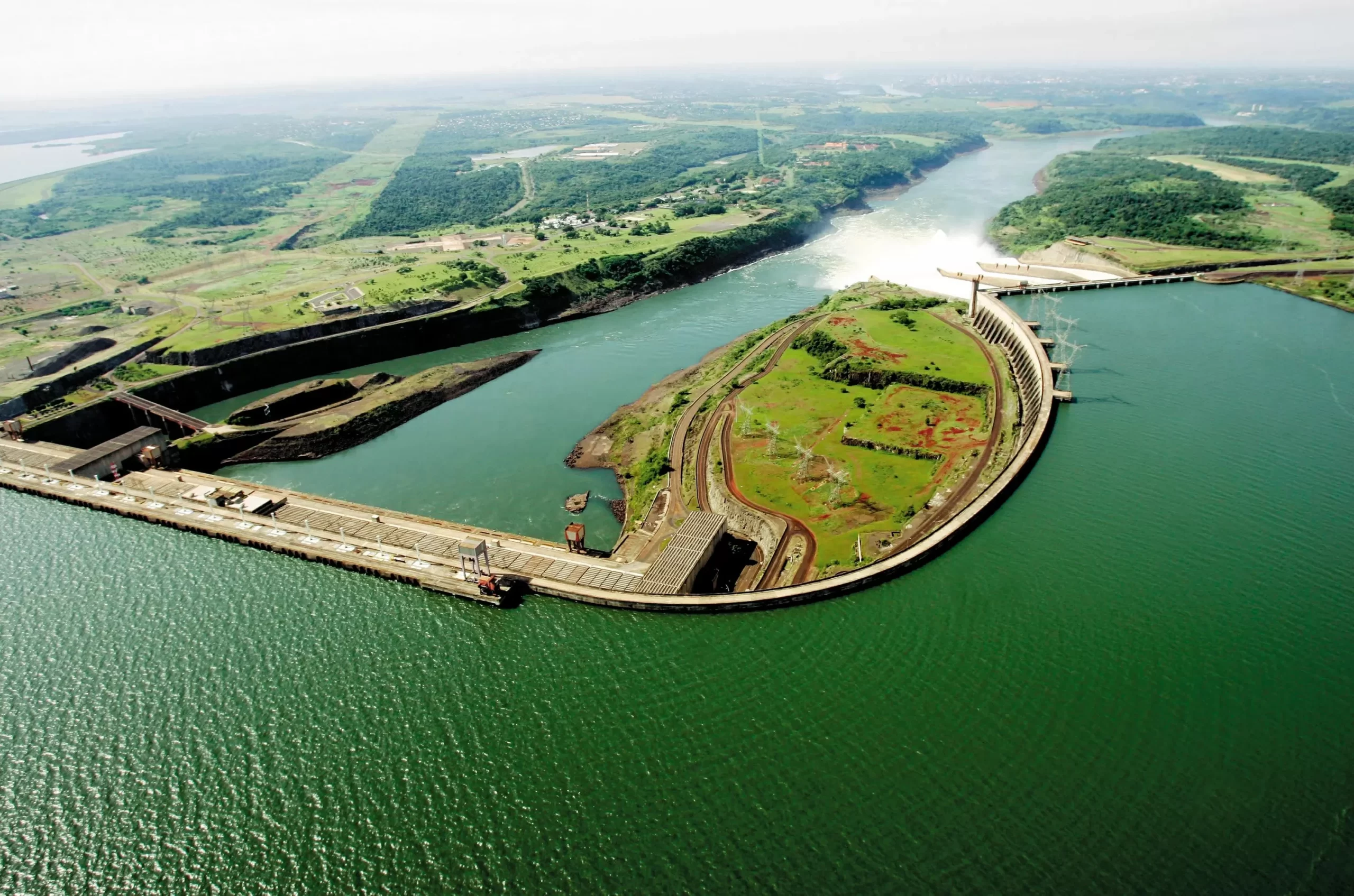Hydroelectric energy is generated by converting the kinetic energy of water into electrical energy, using turbines that drive generators. Brazil is widely recognized for being a country abundant in water resources, which makes hydroelectric plants the main source of energy in the country. With approximately 60% of power generation capacity from hydroelectric plants, Brazil is a world leader in this sector, with an installed capacity of 105 GW in hydroelectric plants.
It is essential to emphasize that hydroelectric power generation has significant impacts on the environment and society, although these issues are often neglected. The construction of dams alters the natural course of rivers, resulting in the flooding of areas and affecting the local fauna and flora. In addition, communities close to hydroelectric plants are often displaced from their homes and land, which leads to social and economic conflicts. Decreased biodiversity is also a concern, as this can have negative effects on local populations that depend on these species for their food and livelihoods.
In some areas, the construction of hydroelectric power plants can have significant cultural and historical impacts. For example, in certain regions, hydroelectric dams can flood areas sacred to indigenous communities or places of historic importance, resulting in the loss of cultural and historical heritage. An emblematic example of these neglected impacts is the Belo Monte hydroelectric plant, located in Pará. In addition to climate and environmental issues and the degradation of fauna and flora, the phenomenon of ethnocide of indigenous peoples has become evident. This occurred due to interference in the way of life and land use by these peoples, the flooding of land and the need to relocate some groups. An important aspect highlighted by the indigenous people was the decrease of the Xingu River, which negatively affected fishing.
Hydroelectric power generation can impact water quality, both in the area directly affected by the plant and in the downstream regions of the river. Construction of the dam can trap sediment and nutrients essential to the ecosystem, affecting water quality and river health. Power plant operation can also influence water temperature and oxygen levels, impacting aquatic life.
It is crucial to emphasize that, in addition to hydroelectric plants, it is essential to invest in other renewable energy sources, such as solar, wind and biomass, in order to diversify the country's energy matrix and reduce dependence on hydroelectric plants. This diversification brings economic benefits, such as the creation of jobs and investments in clean and innovative technologies. Committing to the diversification of the energy matrix is a fundamental strategy to guarantee a sustainable and prosperous future. Currently, Brazil has stood out by investing in clean and renewable energy. The Brazilian energy matrix is mainly composed of hydroelectric plants, representing around 50% of installed capacity, followed by solar energy with 12.6%, wind energy with 11.9%, natural gas with 7.9%, biomass/biogas with 7.5%, and others non-renewable sources.
The diversification of the energy matrix brings a series of benefits, both from an environmental and economic point of view. One of the main benefits is the reduction of dependence on non-renewable sources, such as oil and mineral coal, which are finite and polluting. By betting on renewable sources, Brazil can guarantee the country's energy security, reduce greenhouse gas emissions and contribute to mitigating the impacts of climate change. Clean energy is a bet on the future and on sustainability. Faced with increasing climate change, it is essential to seek solutions that reduce greenhouse gas emissions and ensure the preservation of natural resources. The Ministry of Mines and Energy (MME) has estimated an expansion of centralized power generation capacity of 10.3 GW by 2023. By investing in a clean and renewable energy matrix, Brazil is taking an important step towards a future more sustainable and prosperous.
Solutions to the Hydropower Issue: Promoting a Sustainable Approach to Power Generation
Power generation is a complex topic that demands a comprehensive and critical analysis, taking into account not only the economic benefits, but also the environmental and social impacts. In the case of hydroelectric plants, it is essential to highlight the environmental and historical impacts that are often neglected during their implementation, taking into account:
- Comprehensive environmental impact assessment: Before building hydroelectric dams, it is essential to carry out a comprehensive and thorough environmental impact assessment. This includes analyzing possible impacts on fauna, flora, waterways, local communities and areas of historical and cultural importance. This assessment must also take into account long-term effects, including the possibility of future climate change. The implementation of effective mitigation measures must be ensured.
- Prioritization of small-scale projects and PCHs: Instead of large hydroelectric plants, priority should be given to the implementation of small-scale projects, such as Small Hydroelectric Plants (SHPs). These plants have less environmental and social impact, as they require less displacement of communities and changes in the course of rivers. Furthermore, it is important to encourage the use of decentralized renewable energy technologies, such as solar and wind energy, as viable alternatives.
- Development of environmental and socioeconomic compensation programs: It is necessary to implement environmental and socioeconomic compensation programs for communities affected by hydroelectric plants. This includes the adequate relocation of displaced communities, the preservation of areas of historical and cultural importance, in addition to the development of initiatives that promote the generation of local jobs, professional training and support for traditional economic activities in the region.
- Investment in research and innovative technologies: The development of research and innovative technologies is essential to minimize the environmental impacts of hydroelectric plants. This includes improving the efficiency of turbines and generators, reducing water and sediment losses, improving water resource management, and implementing strategies to mitigate impacts on biodiversity and water quality. In addition, it is important to invest in energy storage systems, such as accumulators, to balance the intermittency of renewable sources.
- Promoting the diversification of the energy matrix: In addition to addressing the impacts of hydroelectric plants, it is crucial to promote the diversification of the energy matrix, seeking additional clean and renewable energy sources. This includes encouraging solar, wind, biomass and geothermal energy, among others. By expanding the use of these sources, it is possible to reduce dependence on hydroelectric plants, mitigate the associated environmental and social impacts and strengthen the resilience of the energy system as a whole.
- Strengthening environmental conservation and preservation policies: It is essential to strengthen environmental conservation and preservation policies to protect ecosystems affected by hydroelectric plants. This includes creating protected areas, implementing reforestation measures and promoting the recovery of degraded areas. In addition, it is important to establish efficient governance, with monitoring and enforcement mechanisms to ensure compliance with environmental regulations.
- Encouraging energy efficiency and the rational use of energy: Promoting energy efficiency and the rational use of energy is a fundamental strategy to reduce the demand for new hydroelectric plants. This involves establishing policies and incentives for the adoption of more efficient technologies, raising awareness about responsible energy consumption and implementing conservation practices in the industrial, residential and commercial sectors.
- Encouraging research and development of alternative sources: It is necessary to invest in research and development of alternative sources of energy generation, such as tidal energy, energy from ocean currents and wave energy. These sources have the potential to complement the energy matrix, reducing dependence on hydroelectric plants and expanding the options for renewable sources.
- Promoting dialogue and public participation: It is essential to involve affected communities and society in general in the decision-making process related to hydroelectric plants. This includes promoting transparent dialogues, public consultations and active stakeholder participation. The involvement of civil society, non-governmental organizations and specialists contributes to the search for more balanced and sustainable solutions.
- Environmental education and awareness: Investing in environmental education and awareness programs is essential to promote a change in mentality and habits regarding the generation and consumption of energy. It is important to educate people about the impacts of hydroelectric dams, the available alternatives and the importance of energy sustainability. This can be done through awareness campaigns, school curricula and training programmes.
By adopting these solutions, Brazil can face the challenges related to hydroelectric plants in a more efficient and sustainable way, ensuring a balance between economic development, environmental preservation and the well-being of local communities. The transition to a diversified and sustainable energy matrix is essential to promote a cleaner, more resilient and prosperous future for the country. By choosing this path, it is possible to minimize the environmental and social impacts of hydroelectric plants, promoting a more sustainable approach to energy generation. These measures aim to ensure a balance between economic development and the preservation of natural resources, providing a sustainable future for present and future generations. By implementing these solutions, Brazil can become an international example of good practices in energy generation, contributing to the mitigation of climate change and conservation of the environment.




